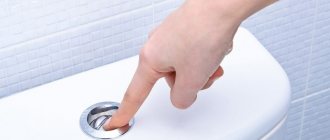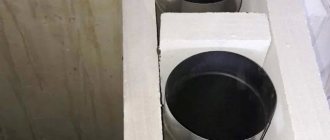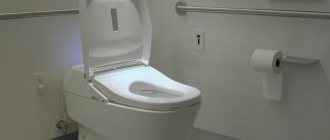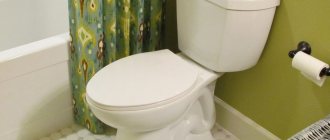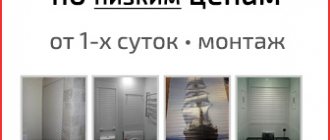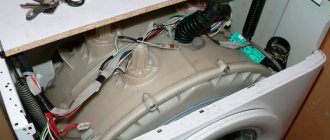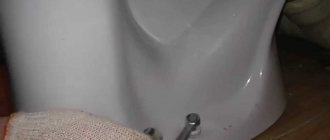Tank maintenance
Installation of the mechanism
If necessary, you can install the drain mechanism in the tank yourself. This is done either when replacing a failed system, or when purchasing a separate tank and separate fittings.
In this case, work is performed according to the following algorithm:
Inlet and drain mechanisms for replacement
- For replacement, we purchase fittings suitable for our tank model. The most important parameters are the location of the inlets (top or side), their sizes, the size of the drain hole and the overall dimensions. Ideally, it is advisable to take a mechanism for the same model - it will definitely work.
- Now turn off the water and press the drain button to remove everything that remains in the tank.
Press the button in and unscrew the locking ring.
- The toilet flush button is carefully unscrewed, after which we are able to remove the lid.
- Disconnect the water supply hose.
- Unscrew the nuts securing the filler pipe. We remove the part itself from the hole.
Removing the intake valve
For structures with bottom water supply, it is advisable to place a small container under the hole. Liquid that collects at the bottom of the tank and does not go down the drain will flow into it.
- We dismantle the internal part of the fittings, removing it from the tank.
We remove the inner part of the reinforcement by unscrewing it from the mount
Float misalignment repair
If the toilet does not fill with water at all, this is unlikely to happen as a result of the float being misaligned. But in the case when it enters the system, but not in the required volume, then the float should be checked for its correct location.
To do this, you need to open the lid - under it you will see water, with a mechanism located in it and a lever, at the end of which a special buoy is attached - a float. It is this part of the device that is responsible for drawing water to the required level, after which it closes the inlet valve. It also happens that the toilet leaks after flushing; this may also be due to the float.
In case of misalignment, it begins to prematurely interrupt the supply of liquid, which ends in the inoperability of the device. The displacer is carefully placed by hand into the required position - after this, the operation of the system should be restored.
Toilet flush mechanism: types, installation and maintenance
Articles
A toilet flush system is a mechanism that is mounted inside the tank. To make using the toilet convenient, the flush mechanism must be correctly selected, installed and configured. It is these issues that the article will be devoted to.
This system is responsible for supplying and draining water
Problems with the button
Even the best-quality toilet has problems from time to time. Basically, you can determine the cause of the breakdown yourself and eliminate it. For example, the flush button may break. It activates the mechanism for raising the bulb and draining the water. The button breaks when pressed too hard. Pressing it sharply can damage the seat. There are also situations when the lever bends when pressed. In any case, replacement of components will be necessary.
Feces in children
Many mothers are interested in what baby's stool should be like.
It is worth paying special attention to this factor, since gastrointestinal diseases are especially severe at an early age. At the first suspicion, you should contact your pediatrician immediately
In the first days after birth, meconium (dark color) comes out of the body. During the first three days, it begins to mix in. On the 4-5th day, feces completely replace meconium. During breastfeeding, golden-yellow feces are a sign of the presence of bilirubin, paste-like, homogeneous, and acidic. At the 4th month, bilirubin is gradually replaced by stercobilin.
Preventing poor flushing
The toilet often becomes a place where foreign objects accumulate. Therefore, it is important to monitor its condition all the time so that drainage problems do not occur again. To do this, it is important to remove foreign objects from the toilet at all times.
Regularly chemically clean the tank and the bowl itself. For this purpose, household chemicals are used. You can clean the sewer mechanically using a plumbing cable.
Regularly open the tank lid and check whether the fittings are working correctly. Breakdowns in this part of the device are easier to prevent than to fix.
Reasons why the toilet doesn't flush well
The ways to solve the problem and the sequence of actions largely depend on what exactly caused it. Often the reason lies in the sewer outlet pipe. Due to its blockage, wastewater cannot pass through. In another case, the problem is hidden in the drain tank. Sometimes, due to the breakage of the hollow plastic bulb, a little liquid accumulates in the tank. Defects appear in the vessel, due to which it fills with water. As a result, it is immersed in water more than necessary. A metal lever in the form of a rod is used to secure the vessel. It bends when used. This causes malfunctions in the opening and closing system of the outlet. If the outlet valve is not working properly, the tank does not fill completely. And the outlet often becomes clogged with suspended matter present in the water. Sometimes the sealing parts of the release device wear out or the button in the tank lid breaks. It is not difficult to understand why the water in the toilet does not flush:
- When a pipe becomes clogged during flushing, water accumulates in the toilet bowl. Its level rises greatly above normal, and leakage occurs slowly.
- The lack of water in the tank is easily determined by a simple inspection.
- The failure of the bulb is determined after opening the lid of the drain tank and inspecting the mechanism for correct operation.
- Breakage of the exhaust valve is determined after moving the lever holding the bulb to different positions. During normal operation, the top opening remains completely closed and water flows freely from below.
What should you pay attention to when choosing a new set of plumbing fixtures?
In this article we will try to figure out why the toilet does not flush well. At the same time, we will learn how to select a toilet with a good flush, listing the main design features that affect its quality.
In this case, it looks like a bad flush could mean a ruined work day. First, however, let's look at the reasons for the following scenario: everything was fine, the toilet worked like a clock; but after a certain point the flushing became noticeably worse.
The most efficient drainage systems
Those who are just about to purchase a toilet should think about choosing the type of flush. The most powerful pressure is provided by designs with a high tank, that is, located almost under the ceiling. But due to their unpresentable appearance and loud noise, they are not used in apartments today - only in public toilets.
The currently popular “Compacts” use two types of drainage:
Water from the tank first rushes into the surrounding channel under the rim, then from there it pours into the bowl, so that the whole of it is washed evenly. Such a system is positioned as more effective, but this is a controversial issue. On the one hand, splashes are removed from the entire surface of the bowl and it actually becomes cleaner. But on the other hand, the flow intensity on the rear wall, which is most susceptible to contamination, decreases. The shower drain has one more drawback: if the water quality is low, the channel under the rim quickly becomes clogged with sediment;
soul-shaped (circular).- cascade _ All the water is discharged along the back wall, so that the side and front walls are almost not washed.
Much depends on the shape of the bowl. In visor and funnel-shaped ones, impurities are washed off well, in dish-shaped ones - not always. Therefore, the latter have lost popularity and are found today mainly only in hospitals.
Types of sewer clogs
If the sewer system in a house is operated in violation of all the rules for its use, then over time, blockages will inevitably appear in the collector.
If the sewer system in a house is operated in violation of all the rules for its use, then over time, blockages and plugs inevitably appear in the collector, which impede or completely stop the flow of wastewater. As a result, either someone from an apartment building or the owners of a private building will suffer from at least an unpleasant odor in the living space.
- It is strictly forbidden to flush used personal hygiene items, such as pads, diapers, tampons, etc., down the toilet. Only flushing toilet paper is allowed.
- It is prohibited to flush bulk construction mixtures such as cement, sand, chalk, clay, etc. down the drain.
- Accidental flushing of rags and other similar items down the drain should be avoided.
- It is advisable to install grease traps in the kitchen, which will prevent the deposition of heavy greasy deposits on the walls of the collector. This, in turn, can create fecal growths-stalactites in the system and impede the flow of gray water.
Important: if there are malfunctions in the sewer system in a private or apartment building, you should not solve the problem yourself. It is better to invite a specialist who will determine the location of the traffic jam and eliminate it.
It is always worth remembering that a traffic jam can form either in a specific place in the sewer system in an apartment or in a private house, or at any point in the central riser. If the last option is checked, then the drains will have nowhere to go but to return back from the blockage under the influence of hydraulic force. As a result, fecal or gray water will try to escape through the unoccupied openings of the bathtub, sink, and other plumbing fixtures.
Clearing the blockage
A small child can easily throw his toy into the toilet. It can get stuck in the water seal of the plumbing. The first thing any person will do is try using a plunger. This simple remedy often solves problems within seconds. By creating serious artificial pressure in the system, the device simply pushes the plug further through the pipes.
Try using a plunger
This can all end well. Having flown through the pipes, the interference will simply jump out into the expanses of the city sewer and will no longer be able to bother anyone. But if the house is multi-story, then having slipped down straight pipes, the blockage may encounter a new obstacle in the form of a turn in the system.
If the pipe is tightly clogged, then everything that is washed away from the upper floors will be on the floor of the residents of the first tier. The top guests, without exception, will see slowly draining water in their toilets instead of a rapid flow.
In this case, a plumbing cable will correct the situation. From the site of a real disaster, namely from the toilet on the first floor, it is necessary to pull out the plug using a flexible shaft or destroy it. Usually such a tool has a hook at the end. It can be used to remove rags and other soft items. There are cables with removable ends. One of them is capable of breaking the cork if it cannot be removed.
Cleaning cable
Blockages in pipes can be caused by organic debris: hair, fats, food and other objects. You can cope with them using active chemistry. There are many products sold in stores that can dissolve organic matter. After reading the instructions, you need to pour or pour the active substance into the drain and wait time for it to take effect.
This method is not suitable for residents of private houses who use a biological station for wastewater treatment. The active environment in the chemical will kill the beneficial bacteria needed for the system to function.
There is another way to deal with blockages that occur in the toilet water seal. But not everyone can cope with it. The volunteer or the punished culprit (if it is not a child) puts on rubber gloves and tries to remove the obstacle from the drains with his hand. The result depends on the perseverance and impressionability of the person.
What to do
If you believe the clog is in the trap or outlet, you can try using a plunger or plumbing cable to remove it.
plunger
For use in a toilet, you need a plunger of a larger diameter than for sinks, since the cross-section of the pipe is much wider. If you don’t have a plunger and are just planning to buy one, you can choose a model with replaceable nozzles or an automatic device, where the pneumatic shock is created not with the help of your force, but mechanically.
How to use a classic plunger:
- Place the plunger against the toilet drain hole and make sure that it fits snugly against the surface; the device should create a vacuum inside the pipe.
- Make several back-and-forth movements.
- Pull the plunger towards you.
- Repeat.
Ideally, after the first flush in the toilet water, you will see pieces of dirt that have clogged the drain. They need to be pulled out with gloved hands and thrown into a pre-prepared garbage bag.
Plumbing cable
The plumbing cable is suitable for cleaning any sewer pipes in the house, including toilets.
- Unwind the cable completely.
- Start immersing it in the water and carefully push it inside the pipe, changing direction.
- Once you have pushed the cable deep enough, slowly pull it out.
- Remove any dirt remaining on it and throw it into a pre-prepared trash bag.
These steps must be repeated 3–5 times until the cable begins to come out clean, without large pieces of dirt.
After using the plunger and/or cable, drain the water to check its current and, if everything is in order, use a special pipe cleaner, such as:
- Domestos for blockages
- Sanfor
- Mole
- Tiret
- Deboucher
They will help dissolve and remove remaining contaminants on the pipe walls.
Due to the large diameter of the pipes, cables with a brush at the end are well suited for toilets.
Main reasons
Often the toilet does not flush well due to problems with the water drainage system itself. To solve the problem yourself, you must first identify the source of the problem.
- If the water stagnates, then most likely there is a blockage in the sewer . When the liquid passes, but slowly, this means that the blockage is small.
- . With prolonged use, deposits appear on the walls, which interfere with water circulation. The pipe can become overgrown with them, then only 1/3 of the original diameter remains. This happens especially quickly if water is supplied from underground sources. In this case, it is enriched with mineral salts, which additionally clog the drain.
- It is worth checking whether there is water in the tank itself. It happens that scale gets into the sewer, which clogs the hose. Also, the flushing process may be disrupted due to the lack of a tank lid. It must always be reinstalled.
- Debris may have gotten inside the drain . Sometimes it's even rubber hoses from the float valve. They are used to ensure that water from the sewer is collected as silently as possible. Usually the hose comes off if the reservoir cap is not in place.
- The float valve is not adjusted or is set incorrectly. As a result, it shuts off the water supply prematurely.
- The tank is constantly leaking. It simply does not have time to fill with liquid, because it constantly drains.
- The float valve is clogged with debris . Its design has a nozzle into which scale or grains of sand can fall. This does not happen if a filter is installed in the hose in front of the tank.
- The line to the tank is clogged with some debris or overgrown. This problem is especially relevant if the house has steel pipes.
In a private home, problems with the toilet look a little different. The sewage system here is arranged differently than in apartments. Often, standards are not followed during installation, so the liquid flows slowly. Experts identify a number of reasons for poor water permeability associated with poor-quality installation and the devices themselves in general.
- No fan boner. This pipe serves as ventilation for the sewer system. It allows the accumulated gases to escape. In the absence of a vent riser, air plugs form inside the pipes. Because of this, the water stops or simply loses speed. There is an accompanying sign of this problem: gases still find a way out of the sewer. In this case, an unpleasant odor can be heard from the toilet, bathtub and sinks.
- Incorrect pipe slope . The problem is related to improper drainage in general. The reason may be either in the section that leads to the septic tank or in the section that leads to the connecting pipe. There is no simple way to fix these problems.
- . If the plumbing itself is new, then that may be the problem. A toilet bowl with a shelf often becomes a source of trouble for its owners. Modern models often have a drain in the center or with a slight slope. In this case, the bowls are shaped like funnels.
- Location of the drain hole in the toilet. Just one water outlet in the center will not do the job. Flushing in a circle is much better and more durable.
Sometimes the reasons are even more banal. For example, models with a button are fraught with danger. Especially if the tank cap was removed and installed incorrectly. In this case, you may notice that the toilet constantly flushes a small amount of water.
If it was after cleaning the tank that the flush began to work poorly, then you should make sure that the structure was assembled correctly.
It's not just plaque that can clog water drain holes. Sometimes a simple piece of paper thrown into the toilet also leads to similar problems. It can also cling to deposits inside the drain pipe. In this case, the water does not drain or does so too slowly.
Types of faults
Water in the plumbing may not flow through for only one reason - a clogged sewer. However, in order to fix the problem, you need to figure out why the water is rising in the toilet, or more precisely, where it is coming from.
There can only be two options:
- Drains from the cistern.
- Comes from the sewer.
Below we will look at how to stop the water in the toilet in both cases and remove the blockage.
Removing a blockage using a plunger
Normal clog
If you are faced with a regular blockage, and water enters the toilet from the flush tank, then you should first turn it off to avoid overflow. Why there is water in the toilet is clear to everyone; it all comes down to a blockage in the system.
At the same time, many people do not think about what to do if there is water in the toilet, but immediately call a plumber. As a result, you have to wait a long time for their arrival and pay for the work done.
Therefore, in most cases, it is more advisable to remove the blockage with your own hands, for example, using an ordinary plunger.
This is done as follows:
- The bowl of the plumbing fixture is filled with water so that its level covers the drain hole.
- For greater efficiency, drains and overflows of nearby plumbing fixtures (bathtub, sink, etc.) are closed.
- Then a plunger is placed over the drain hole, and it should completely block the drain.
- After this, several active pumping motions are done.
- If after this the water in the toilet begins to swirl and gurgles into the drain, it means the blockage has been removed.
- If the water does not leave the bowl or begins to leave slowly, the operation should be repeated several more times.
- After the blockage is cleared, you need to pour a pan of boiling water into the system.
If you can’t solve the problem with a plunger, you can use special chemicals to clean the drain. The price of such drugs is quite affordable, so anyone can clean the system in this way.
Drain cleaner
The only thing when purchasing a product is to pay attention to what type of pipes it is intended for. This information is contained in the instructions on the packaging.
If the product is incompatible with your type of pipes, it may further damage the sewer system.
Another way to remove a blockage is to use a plumbing cable, which is inserted into the sewer through the drain hole and at the same time rotated slowly. It must be said that cleaning with a cable is the most effective.
Scheme for cleaning a toilet with a plumbing cable
Blocked riser
Now let's look at what to do if water rises in the toilet when the flush cistern is closed. Let us immediately note that this malfunction is more serious and unpleasant, since it is impossible to independently prevent the flow of water into the toilet.
The reason for this is that the sewer riser is clogged below the level of your toilet. As a result, according to the principle of communicating vessels, all drains will rise up into your toilet through outlets and can flood the apartment.
Therefore, if such a problem is discovered, you must immediately contact the appropriate authorities, and also go around the neighbors living higher up the riser with a request not to use the plumbing until the problem is fixed.
Check valve for sewerage
Advice! Installing a check valve will prevent your apartment from flooding with sewage. This device is especially relevant for residents of the first floors of high-rise buildings.
Identifying the cause
When a problem arises that the toilet does not flush, then first you need to figure out the cause of the poor flush. In most cases, the problem lies in the disruption of the normal operation of the flushing system. The cause, of course, could be an installation error, but usually the problem is associated with a clogged sewer system.
To fix it yourself, you should find out how the device works. If there is a simple blockage, you can easily remove it. To clarify this point, you need to observe how the water flows into the drain hole. It is worth examining the drain mechanism for damage.
If you find out that it goes away a little, then the plug is small. If the liquid does not go away, then the reason should be looked for elsewhere, we will talk about this below.
As general information, let's say that the drain hole has a small diameter. When the device is in operation for a long time, accumulation of various types of deposits (limestone) is observed. Thus, it is known from practice that a pipe can become overgrown up to 1/3 of its diameter.
Also, first of all, you should look at the presence of liquid in the tank. It happens that scale has got into the water supply, which can clog the water supply hose to the float valve. The flushing process will also be disrupted if the lid is removed. When removed, it should always be returned to its place. So, let's look further - the toilet flushes poorly, what should we do?
Obstructions in the drain hole
The first thing to check if the toilet doesn't flush well is the drain hole. You can understand that the problem is a clogged drain by a characteristic sign - a significant decrease in pressure. The water flows too slowly, the pressure is weak.
The tank has a small hole at the bottom. It is closed with a special valve. Over time, this hole becomes clogged and lime deposits accumulate on it. As a result, water cannot flow normally into the toilet.
The solution is to take phosphoric acid or 3 standard packages of citric acid. The selected substance is added to the tank and left for several hours. The ideal option is to leave this composition overnight. In the morning all that remains is to flush it down the toilet.
Often the cause of poor water pressure is a foreign object, which, surprisingly, can get into the tank at any time. These are pieces of hose, o-rings and other items. Therefore, when disassembling the structure, you need to pay attention to the bottom of the tank.
Plumbing cleaning
Over the years, old plumbing loses its original qualities and begins to function problematically. This is due to damage to the enamel. Chips and cracks appear on it. Over time, even the most expensive enamel becomes rough. As a result, waste does not quickly enter the sewer system. With each press of the button, the passage becomes more and more clogged and the water begins to drain worse.
The best way out of the situation would be to replace the toilet with a new model. But this cannot be called practical advice, since such problems need to be solved immediately.
The solution is to arm yourself with a plunger, chemicals, rags and plumbing rope. It is not a fact that all the proposed devices will necessarily be needed. Most often, high-quality cleaning requires the first two products.
There are two types of plunger - regular and pneumatic. Its activation creates pressure differences, and the water begins to independently push dirt through the pipe. True, it is not possible to effectively clear the passage every time.
Using a variety of chemicals, you can quickly dissolve accumulations of dirt on any part of the duct. You just pour the acid into the toilet and it starts to work. At the end, you can use a plunger or a special brush again.
The cable is used only in the most difficult cases. If no alkalis or other means help, it means that something is stuck in the pipe that can only be reached with a plumbing cable. It is pushed into the pipe, rotating. It is advisable not to damage the enamel of the toilet bowl.
Damage to enamel
Ceramic toilets, which are the most common, are coated with a smooth glaze or enamel. Over time, the coating wears out, and when struck by carelessness, scratches, chips and cracks remain on it. As a result, the smooth surface turns into a rough one and begins to resist the flushing of sewage.
to the enamel is a sure sign that it is time to purchase a new toilet, but if it is not possible to do this yet, they resort to temporary restoration:
- After rinsing and drying the toilet, rough areas are treated with fine-grained sandpaper;
- thoroughly wash the toilet so that no dust remains, then dry and degrease;
- waterproof sealant or ceramic putty is applied to problem areas;
- after waiting for the mixture to dry completely, paint the treated areas with powder paint using a paint gun;
- wait for the paint to dry completely (about 3 days are required) and resume operation of the device.
The improvised glaze does not last long, so it is recommended to plan to purchase a new toilet in the near future.
Problem prevention
The best way to solve problems is to prevent them from occurring. Therefore, in order not to have to often complain about why the toilet doesn’t flush well, you should accustom yourself to periodically carry out preventive maintenance:
- Clean the drain channels every week using special products.
- Periodically inspect the inside of the tank and fittings. Add cleaning tablets to the water.
- Do not throw foreign objects or toilet paper into the toilet (even if it says you can do so).
- Regularly clean the surface of the bowl with detergents and disinfectants.
It can be argued that in most cases, the lion's share of plumbing problems do not represent any very complex problems. With a clear understanding of what to do if the toilet does not flush: the causes of the problems and their solutions can only be a slight delay in this “ticklish” issue until everything falls into place again.
It is worth noting that most of the problems associated with flushing the toilet can be solved independently without calling utility workers or plumbers to your home.
